Business and Business Environment: Toyota Corporation Analysis Report
VerifiedAdded on 2020/12/18
|14
|3842
|173
Report
AI Summary
This report provides a comprehensive analysis of Toyota Corporation's business and its environment. It begins with an introduction to the company, highlighting its global presence and operational scope. The report then delves into the different types and purposes of organizations, including p...
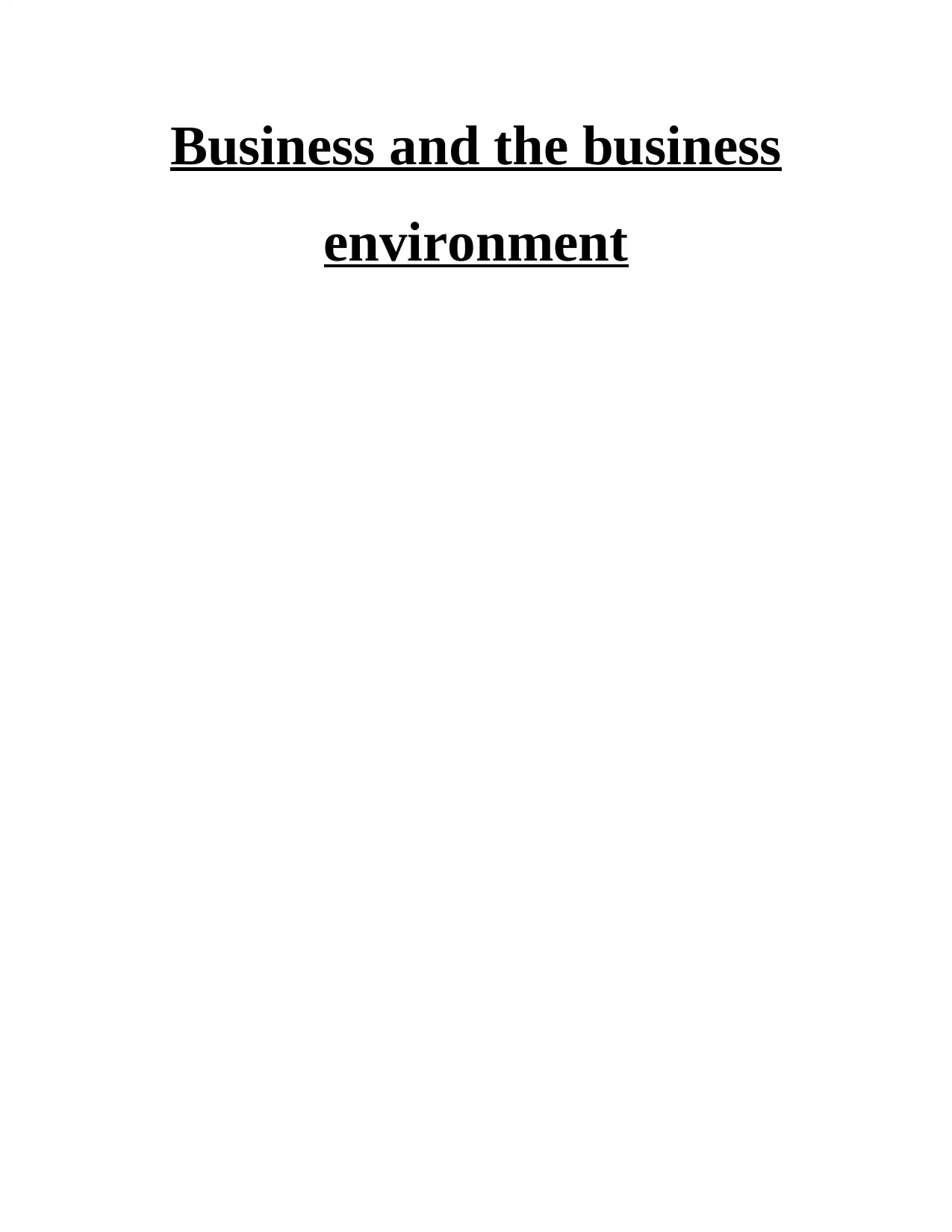
Business and the business
environment
environment
Paraphrase This Document
Need a fresh take? Get an instant paraphrase of this document with our AI Paraphraser
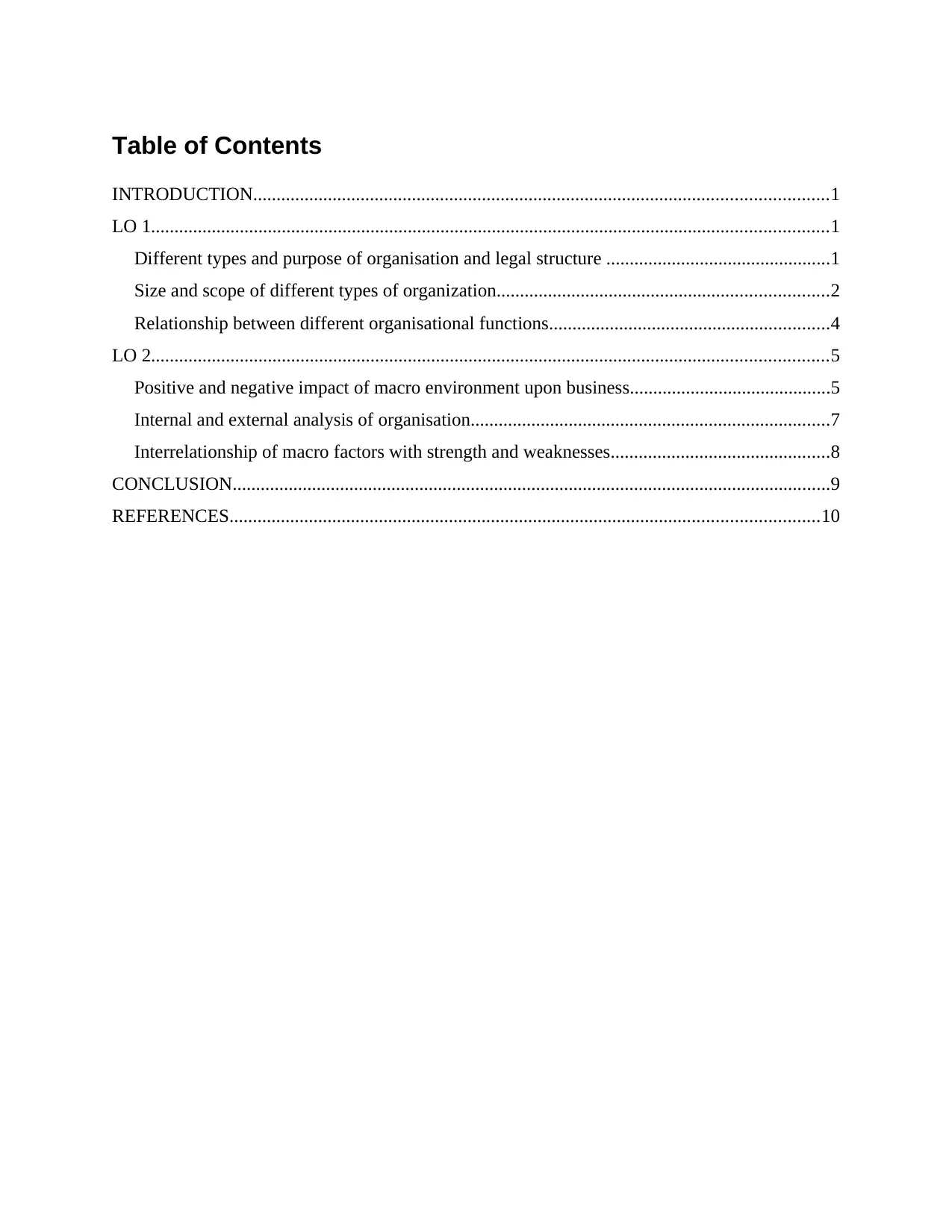
Table of Contents
INTRODUCTION...........................................................................................................................1
LO 1.................................................................................................................................................1
Different types and purpose of organisation and legal structure ................................................1
Size and scope of different types of organization.......................................................................2
Relationship between different organisational functions............................................................4
LO 2.................................................................................................................................................5
Positive and negative impact of macro environment upon business...........................................5
Internal and external analysis of organisation.............................................................................7
Interrelationship of macro factors with strength and weaknesses...............................................8
CONCLUSION................................................................................................................................9
REFERENCES..............................................................................................................................10
INTRODUCTION...........................................................................................................................1
LO 1.................................................................................................................................................1
Different types and purpose of organisation and legal structure ................................................1
Size and scope of different types of organization.......................................................................2
Relationship between different organisational functions............................................................4
LO 2.................................................................................................................................................5
Positive and negative impact of macro environment upon business...........................................5
Internal and external analysis of organisation.............................................................................7
Interrelationship of macro factors with strength and weaknesses...............................................8
CONCLUSION................................................................................................................................9
REFERENCES..............................................................................................................................10
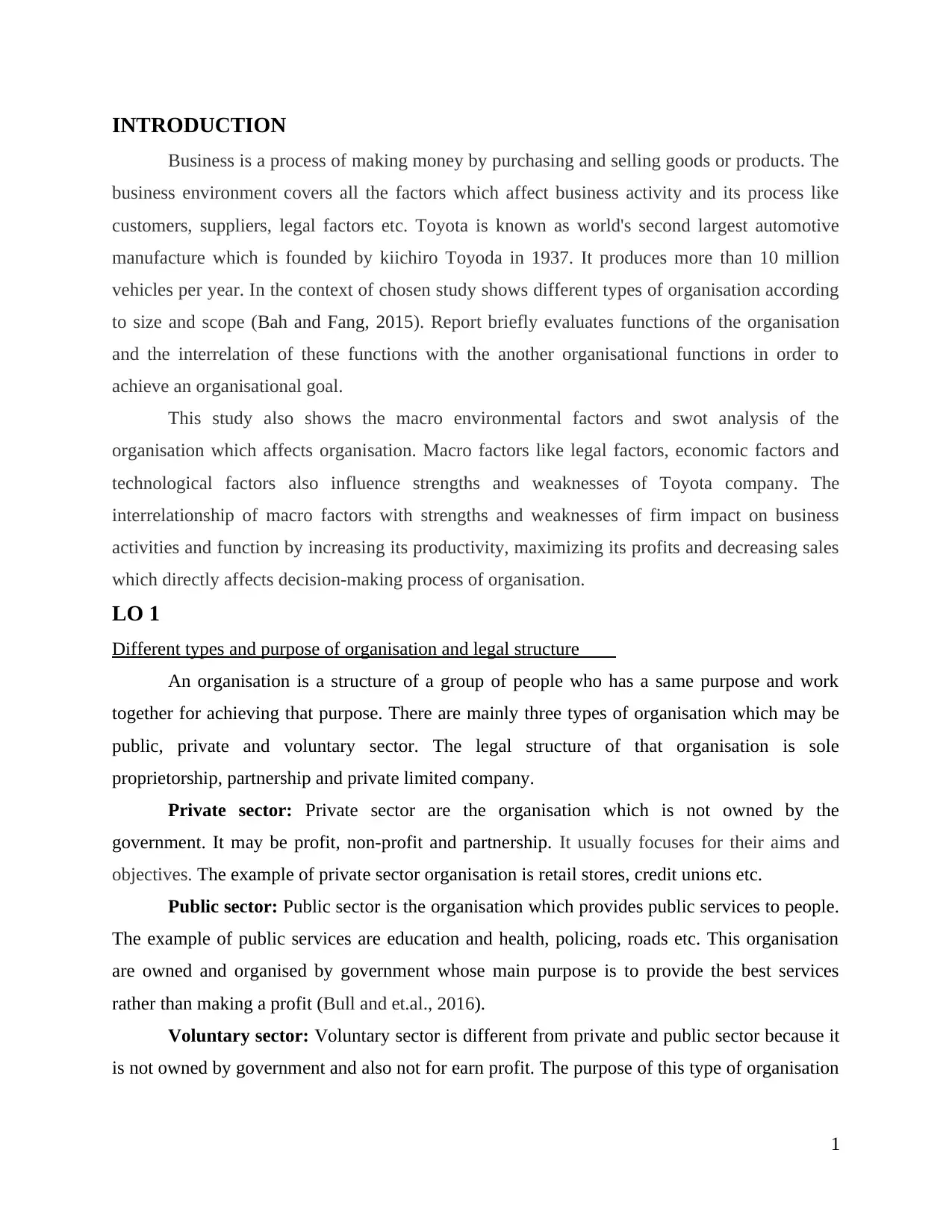
INTRODUCTION
Business is a process of making money by purchasing and selling goods or products. The
business environment covers all the factors which affect business activity and its process like
customers, suppliers, legal factors etc. Toyota is known as world's second largest automotive
manufacture which is founded by kiichiro Toyoda in 1937. It produces more than 10 million
vehicles per year. In the context of chosen study shows different types of organisation according
to size and scope (Bah and Fang, 2015). Report briefly evaluates functions of the organisation
and the interrelation of these functions with the another organisational functions in order to
achieve an organisational goal.
This study also shows the macro environmental factors and swot analysis of the
organisation which affects organisation. Macro factors like legal factors, economic factors and
technological factors also influence strengths and weaknesses of Toyota company. The
interrelationship of macro factors with strengths and weaknesses of firm impact on business
activities and function by increasing its productivity, maximizing its profits and decreasing sales
which directly affects decision-making process of organisation.
LO 1
Different types and purpose of organisation and legal structure
An organisation is a structure of a group of people who has a same purpose and work
together for achieving that purpose. There are mainly three types of organisation which may be
public, private and voluntary sector. The legal structure of that organisation is sole
proprietorship, partnership and private limited company.
Private sector: Private sector are the organisation which is not owned by the
government. It may be profit, non-profit and partnership. It usually focuses for their aims and
objectives. The example of private sector organisation is retail stores, credit unions etc.
Public sector: Public sector is the organisation which provides public services to people.
The example of public services are education and health, policing, roads etc. This organisation
are owned and organised by government whose main purpose is to provide the best services
rather than making a profit (Bull and et.al., 2016).
Voluntary sector: Voluntary sector is different from private and public sector because it
is not owned by government and also not for earn profit. The purpose of this type of organisation
1
Business is a process of making money by purchasing and selling goods or products. The
business environment covers all the factors which affect business activity and its process like
customers, suppliers, legal factors etc. Toyota is known as world's second largest automotive
manufacture which is founded by kiichiro Toyoda in 1937. It produces more than 10 million
vehicles per year. In the context of chosen study shows different types of organisation according
to size and scope (Bah and Fang, 2015). Report briefly evaluates functions of the organisation
and the interrelation of these functions with the another organisational functions in order to
achieve an organisational goal.
This study also shows the macro environmental factors and swot analysis of the
organisation which affects organisation. Macro factors like legal factors, economic factors and
technological factors also influence strengths and weaknesses of Toyota company. The
interrelationship of macro factors with strengths and weaknesses of firm impact on business
activities and function by increasing its productivity, maximizing its profits and decreasing sales
which directly affects decision-making process of organisation.
LO 1
Different types and purpose of organisation and legal structure
An organisation is a structure of a group of people who has a same purpose and work
together for achieving that purpose. There are mainly three types of organisation which may be
public, private and voluntary sector. The legal structure of that organisation is sole
proprietorship, partnership and private limited company.
Private sector: Private sector are the organisation which is not owned by the
government. It may be profit, non-profit and partnership. It usually focuses for their aims and
objectives. The example of private sector organisation is retail stores, credit unions etc.
Public sector: Public sector is the organisation which provides public services to people.
The example of public services are education and health, policing, roads etc. This organisation
are owned and organised by government whose main purpose is to provide the best services
rather than making a profit (Bull and et.al., 2016).
Voluntary sector: Voluntary sector is different from private and public sector because it
is not owned by government and also not for earn profit. The purpose of this type of organisation
1
You're viewing a preview
Unlock full access by subscribing today!
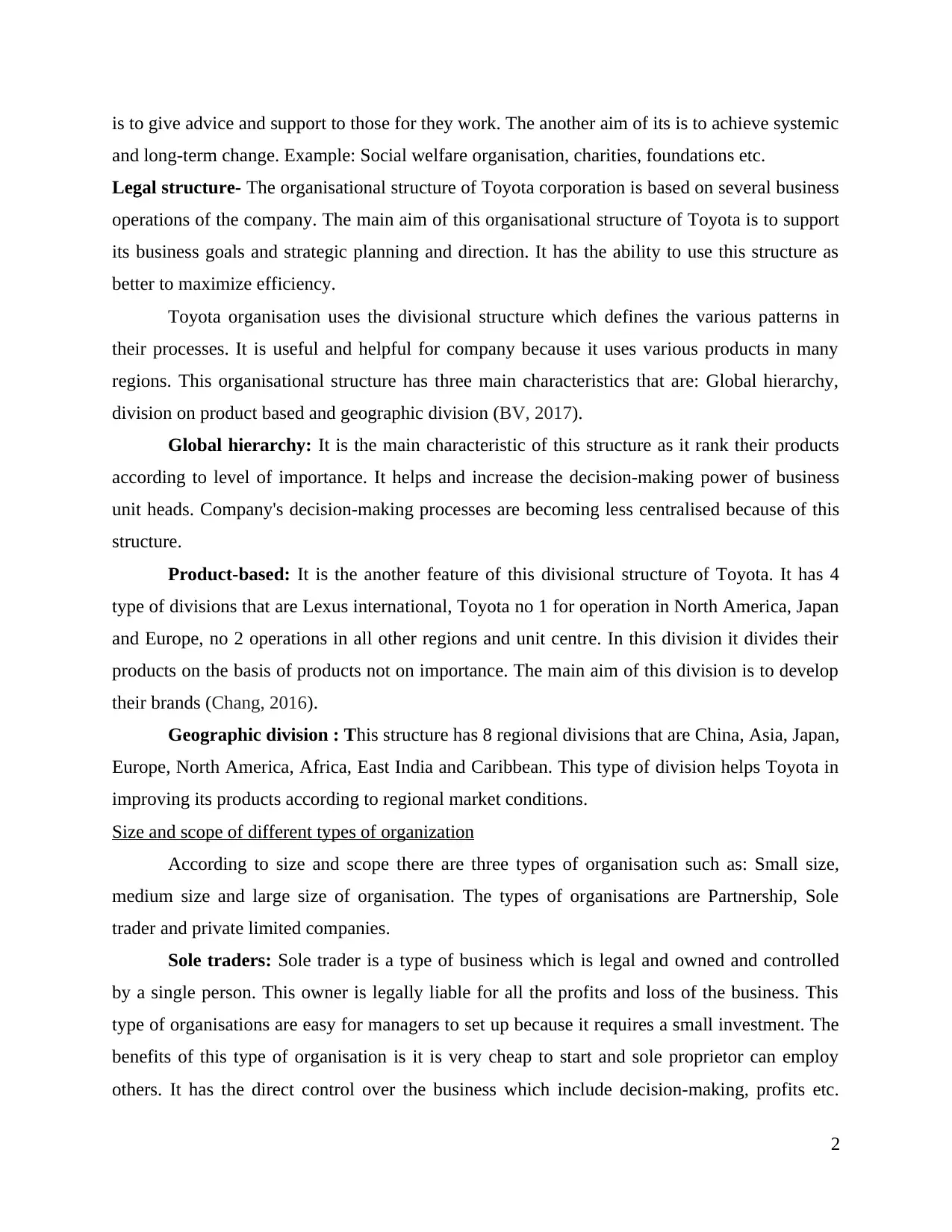
is to give advice and support to those for they work. The another aim of its is to achieve systemic
and long-term change. Example: Social welfare organisation, charities, foundations etc.
Legal structure- The organisational structure of Toyota corporation is based on several business
operations of the company. The main aim of this organisational structure of Toyota is to support
its business goals and strategic planning and direction. It has the ability to use this structure as
better to maximize efficiency.
Toyota organisation uses the divisional structure which defines the various patterns in
their processes. It is useful and helpful for company because it uses various products in many
regions. This organisational structure has three main characteristics that are: Global hierarchy,
division on product based and geographic division (BV, 2017).
Global hierarchy: It is the main characteristic of this structure as it rank their products
according to level of importance. It helps and increase the decision-making power of business
unit heads. Company's decision-making processes are becoming less centralised because of this
structure.
Product-based: It is the another feature of this divisional structure of Toyota. It has 4
type of divisions that are Lexus international, Toyota no 1 for operation in North America, Japan
and Europe, no 2 operations in all other regions and unit centre. In this division it divides their
products on the basis of products not on importance. The main aim of this division is to develop
their brands (Chang, 2016).
Geographic division : This structure has 8 regional divisions that are China, Asia, Japan,
Europe, North America, Africa, East India and Caribbean. This type of division helps Toyota in
improving its products according to regional market conditions.
Size and scope of different types of organization
According to size and scope there are three types of organisation such as: Small size,
medium size and large size of organisation. The types of organisations are Partnership, Sole
trader and private limited companies.
Sole traders: Sole trader is a type of business which is legal and owned and controlled
by a single person. This owner is legally liable for all the profits and loss of the business. This
type of organisations are easy for managers to set up because it requires a small investment. The
benefits of this type of organisation is it is very cheap to start and sole proprietor can employ
others. It has the direct control over the business which include decision-making, profits etc.
2
and long-term change. Example: Social welfare organisation, charities, foundations etc.
Legal structure- The organisational structure of Toyota corporation is based on several business
operations of the company. The main aim of this organisational structure of Toyota is to support
its business goals and strategic planning and direction. It has the ability to use this structure as
better to maximize efficiency.
Toyota organisation uses the divisional structure which defines the various patterns in
their processes. It is useful and helpful for company because it uses various products in many
regions. This organisational structure has three main characteristics that are: Global hierarchy,
division on product based and geographic division (BV, 2017).
Global hierarchy: It is the main characteristic of this structure as it rank their products
according to level of importance. It helps and increase the decision-making power of business
unit heads. Company's decision-making processes are becoming less centralised because of this
structure.
Product-based: It is the another feature of this divisional structure of Toyota. It has 4
type of divisions that are Lexus international, Toyota no 1 for operation in North America, Japan
and Europe, no 2 operations in all other regions and unit centre. In this division it divides their
products on the basis of products not on importance. The main aim of this division is to develop
their brands (Chang, 2016).
Geographic division : This structure has 8 regional divisions that are China, Asia, Japan,
Europe, North America, Africa, East India and Caribbean. This type of division helps Toyota in
improving its products according to regional market conditions.
Size and scope of different types of organization
According to size and scope there are three types of organisation such as: Small size,
medium size and large size of organisation. The types of organisations are Partnership, Sole
trader and private limited companies.
Sole traders: Sole trader is a type of business which is legal and owned and controlled
by a single person. This owner is legally liable for all the profits and loss of the business. This
type of organisations are easy for managers to set up because it requires a small investment. The
benefits of this type of organisation is it is very cheap to start and sole proprietor can employ
others. It has the direct control over the business which include decision-making, profits etc.
2
Paraphrase This Document
Need a fresh take? Get an instant paraphrase of this document with our AI Paraphraser
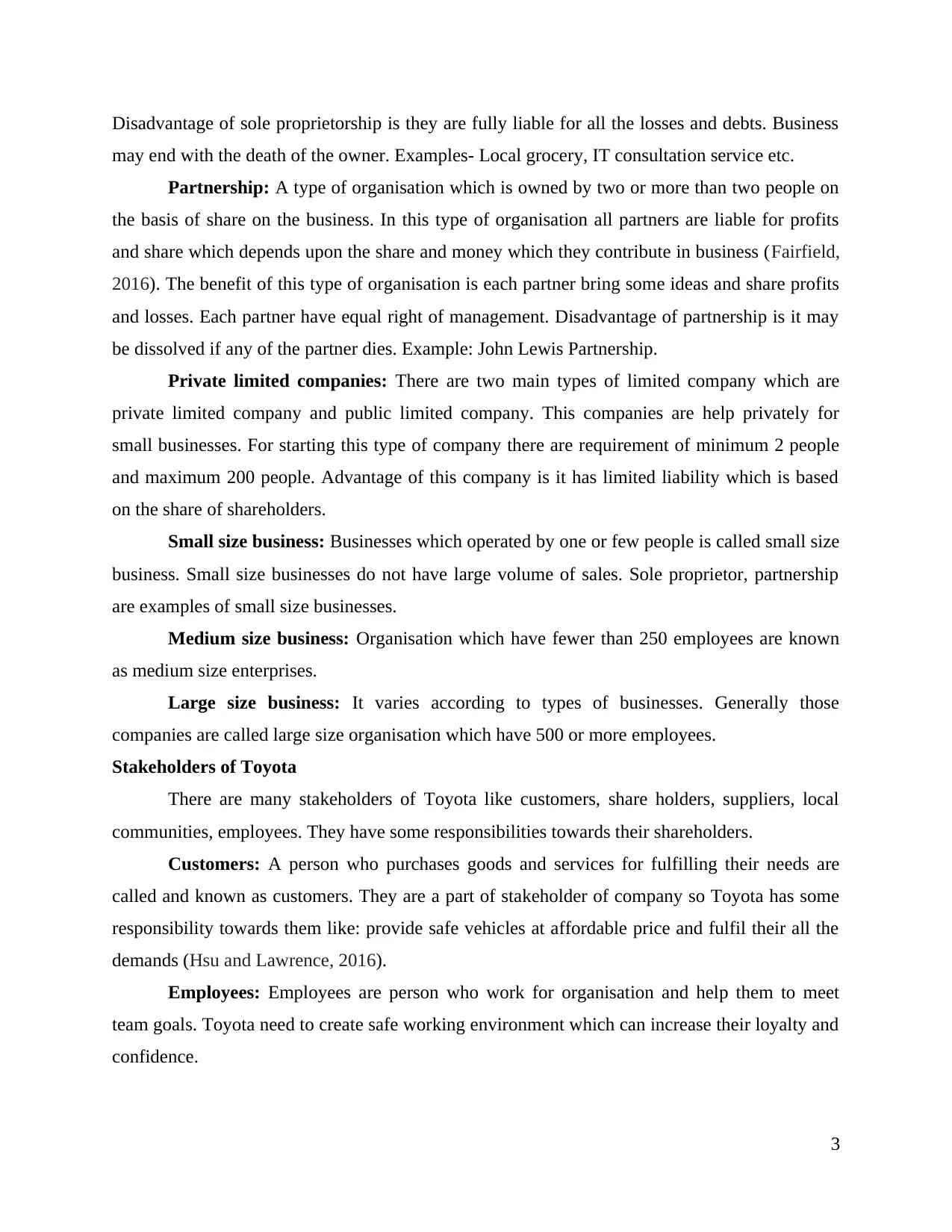
Disadvantage of sole proprietorship is they are fully liable for all the losses and debts. Business
may end with the death of the owner. Examples- Local grocery, IT consultation service etc.
Partnership: A type of organisation which is owned by two or more than two people on
the basis of share on the business. In this type of organisation all partners are liable for profits
and share which depends upon the share and money which they contribute in business (Fairfield,
2016). The benefit of this type of organisation is each partner bring some ideas and share profits
and losses. Each partner have equal right of management. Disadvantage of partnership is it may
be dissolved if any of the partner dies. Example: John Lewis Partnership.
Private limited companies: There are two main types of limited company which are
private limited company and public limited company. This companies are help privately for
small businesses. For starting this type of company there are requirement of minimum 2 people
and maximum 200 people. Advantage of this company is it has limited liability which is based
on the share of shareholders.
Small size business: Businesses which operated by one or few people is called small size
business. Small size businesses do not have large volume of sales. Sole proprietor, partnership
are examples of small size businesses.
Medium size business: Organisation which have fewer than 250 employees are known
as medium size enterprises.
Large size business: It varies according to types of businesses. Generally those
companies are called large size organisation which have 500 or more employees.
Stakeholders of Toyota
There are many stakeholders of Toyota like customers, share holders, suppliers, local
communities, employees. They have some responsibilities towards their shareholders.
Customers: A person who purchases goods and services for fulfilling their needs are
called and known as customers. They are a part of stakeholder of company so Toyota has some
responsibility towards them like: provide safe vehicles at affordable price and fulfil their all the
demands (Hsu and Lawrence, 2016).
Employees: Employees are person who work for organisation and help them to meet
team goals. Toyota need to create safe working environment which can increase their loyalty and
confidence.
3
may end with the death of the owner. Examples- Local grocery, IT consultation service etc.
Partnership: A type of organisation which is owned by two or more than two people on
the basis of share on the business. In this type of organisation all partners are liable for profits
and share which depends upon the share and money which they contribute in business (Fairfield,
2016). The benefit of this type of organisation is each partner bring some ideas and share profits
and losses. Each partner have equal right of management. Disadvantage of partnership is it may
be dissolved if any of the partner dies. Example: John Lewis Partnership.
Private limited companies: There are two main types of limited company which are
private limited company and public limited company. This companies are help privately for
small businesses. For starting this type of company there are requirement of minimum 2 people
and maximum 200 people. Advantage of this company is it has limited liability which is based
on the share of shareholders.
Small size business: Businesses which operated by one or few people is called small size
business. Small size businesses do not have large volume of sales. Sole proprietor, partnership
are examples of small size businesses.
Medium size business: Organisation which have fewer than 250 employees are known
as medium size enterprises.
Large size business: It varies according to types of businesses. Generally those
companies are called large size organisation which have 500 or more employees.
Stakeholders of Toyota
There are many stakeholders of Toyota like customers, share holders, suppliers, local
communities, employees. They have some responsibilities towards their shareholders.
Customers: A person who purchases goods and services for fulfilling their needs are
called and known as customers. They are a part of stakeholder of company so Toyota has some
responsibility towards them like: provide safe vehicles at affordable price and fulfil their all the
demands (Hsu and Lawrence, 2016).
Employees: Employees are person who work for organisation and help them to meet
team goals. Toyota need to create safe working environment which can increase their loyalty and
confidence.
3
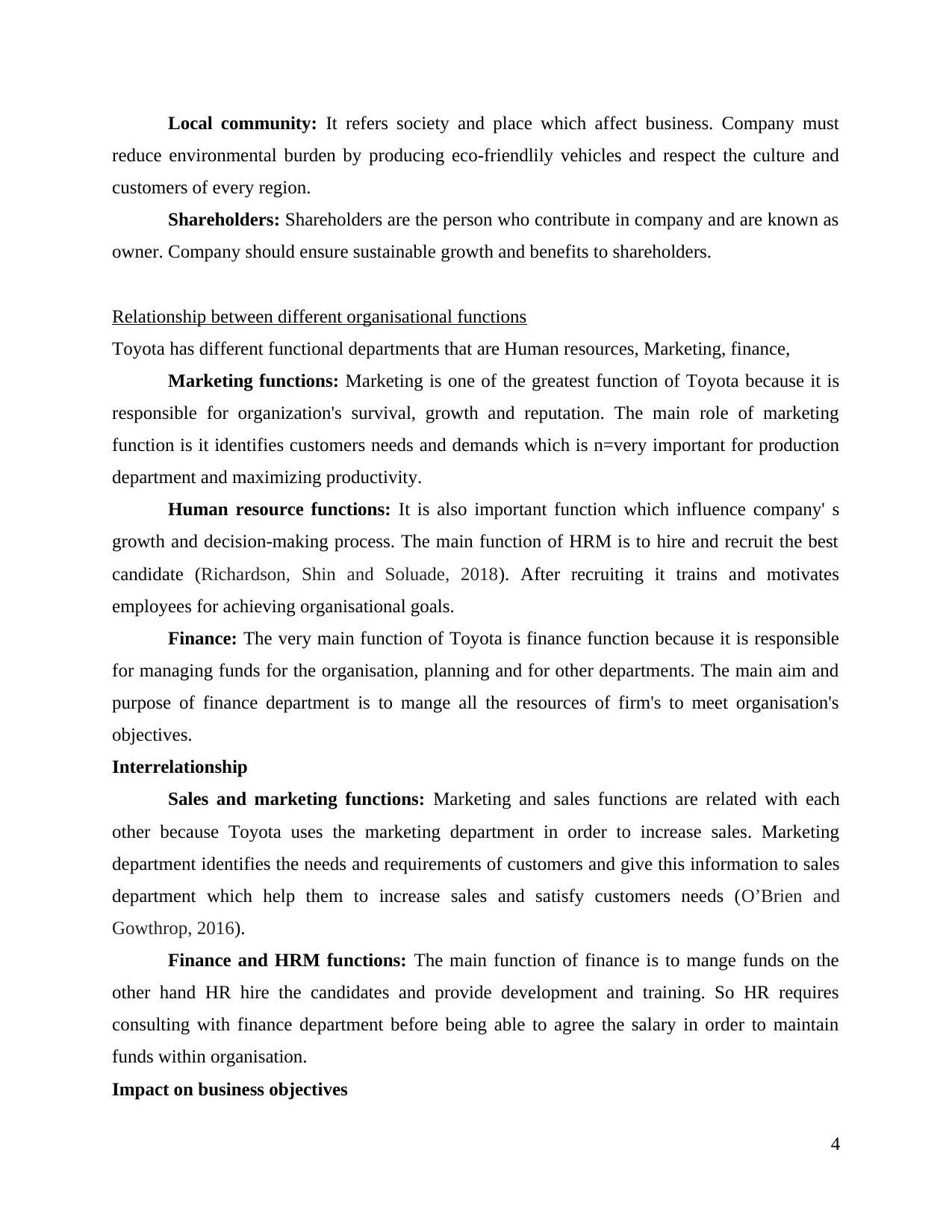
Local community: It refers society and place which affect business. Company must
reduce environmental burden by producing eco-friendlily vehicles and respect the culture and
customers of every region.
Shareholders: Shareholders are the person who contribute in company and are known as
owner. Company should ensure sustainable growth and benefits to shareholders.
Relationship between different organisational functions
Toyota has different functional departments that are Human resources, Marketing, finance,
Marketing functions: Marketing is one of the greatest function of Toyota because it is
responsible for organization's survival, growth and reputation. The main role of marketing
function is it identifies customers needs and demands which is n=very important for production
department and maximizing productivity.
Human resource functions: It is also important function which influence company' s
growth and decision-making process. The main function of HRM is to hire and recruit the best
candidate (Richardson, Shin and Soluade, 2018). After recruiting it trains and motivates
employees for achieving organisational goals.
Finance: The very main function of Toyota is finance function because it is responsible
for managing funds for the organisation, planning and for other departments. The main aim and
purpose of finance department is to mange all the resources of firm's to meet organisation's
objectives.
Interrelationship
Sales and marketing functions: Marketing and sales functions are related with each
other because Toyota uses the marketing department in order to increase sales. Marketing
department identifies the needs and requirements of customers and give this information to sales
department which help them to increase sales and satisfy customers needs (O’Brien and
Gowthrop, 2016).
Finance and HRM functions: The main function of finance is to mange funds on the
other hand HR hire the candidates and provide development and training. So HR requires
consulting with finance department before being able to agree the salary in order to maintain
funds within organisation.
Impact on business objectives
4
reduce environmental burden by producing eco-friendlily vehicles and respect the culture and
customers of every region.
Shareholders: Shareholders are the person who contribute in company and are known as
owner. Company should ensure sustainable growth and benefits to shareholders.
Relationship between different organisational functions
Toyota has different functional departments that are Human resources, Marketing, finance,
Marketing functions: Marketing is one of the greatest function of Toyota because it is
responsible for organization's survival, growth and reputation. The main role of marketing
function is it identifies customers needs and demands which is n=very important for production
department and maximizing productivity.
Human resource functions: It is also important function which influence company' s
growth and decision-making process. The main function of HRM is to hire and recruit the best
candidate (Richardson, Shin and Soluade, 2018). After recruiting it trains and motivates
employees for achieving organisational goals.
Finance: The very main function of Toyota is finance function because it is responsible
for managing funds for the organisation, planning and for other departments. The main aim and
purpose of finance department is to mange all the resources of firm's to meet organisation's
objectives.
Interrelationship
Sales and marketing functions: Marketing and sales functions are related with each
other because Toyota uses the marketing department in order to increase sales. Marketing
department identifies the needs and requirements of customers and give this information to sales
department which help them to increase sales and satisfy customers needs (O’Brien and
Gowthrop, 2016).
Finance and HRM functions: The main function of finance is to mange funds on the
other hand HR hire the candidates and provide development and training. So HR requires
consulting with finance department before being able to agree the salary in order to maintain
funds within organisation.
Impact on business objectives
4
You're viewing a preview
Unlock full access by subscribing today!
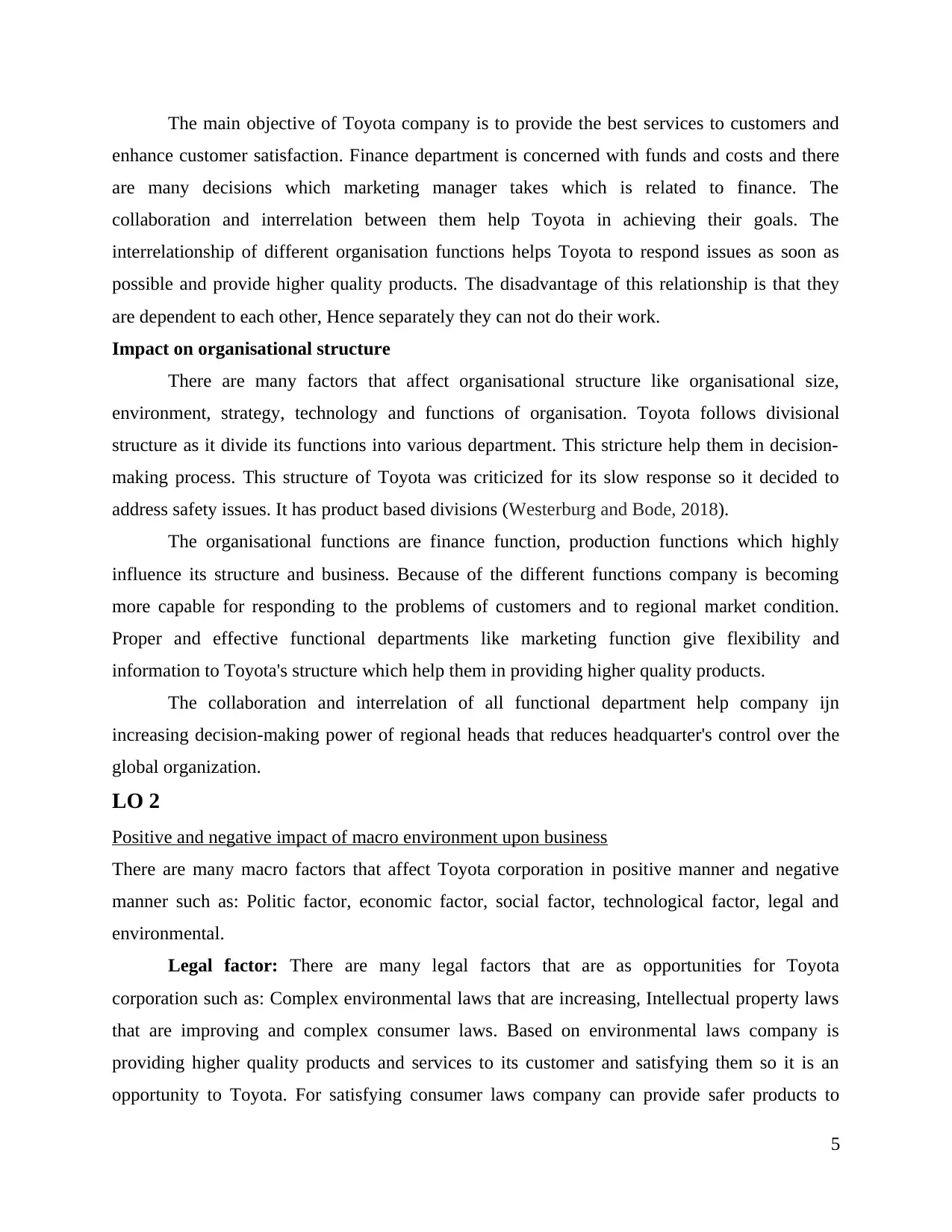
The main objective of Toyota company is to provide the best services to customers and
enhance customer satisfaction. Finance department is concerned with funds and costs and there
are many decisions which marketing manager takes which is related to finance. The
collaboration and interrelation between them help Toyota in achieving their goals. The
interrelationship of different organisation functions helps Toyota to respond issues as soon as
possible and provide higher quality products. The disadvantage of this relationship is that they
are dependent to each other, Hence separately they can not do their work.
Impact on organisational structure
There are many factors that affect organisational structure like organisational size,
environment, strategy, technology and functions of organisation. Toyota follows divisional
structure as it divide its functions into various department. This stricture help them in decision-
making process. This structure of Toyota was criticized for its slow response so it decided to
address safety issues. It has product based divisions (Westerburg and Bode, 2018).
The organisational functions are finance function, production functions which highly
influence its structure and business. Because of the different functions company is becoming
more capable for responding to the problems of customers and to regional market condition.
Proper and effective functional departments like marketing function give flexibility and
information to Toyota's structure which help them in providing higher quality products.
The collaboration and interrelation of all functional department help company ijn
increasing decision-making power of regional heads that reduces headquarter's control over the
global organization.
LO 2
Positive and negative impact of macro environment upon business
There are many macro factors that affect Toyota corporation in positive manner and negative
manner such as: Politic factor, economic factor, social factor, technological factor, legal and
environmental.
Legal factor: There are many legal factors that are as opportunities for Toyota
corporation such as: Complex environmental laws that are increasing, Intellectual property laws
that are improving and complex consumer laws. Based on environmental laws company is
providing higher quality products and services to its customer and satisfying them so it is an
opportunity to Toyota. For satisfying consumer laws company can provide safer products to
5
enhance customer satisfaction. Finance department is concerned with funds and costs and there
are many decisions which marketing manager takes which is related to finance. The
collaboration and interrelation between them help Toyota in achieving their goals. The
interrelationship of different organisation functions helps Toyota to respond issues as soon as
possible and provide higher quality products. The disadvantage of this relationship is that they
are dependent to each other, Hence separately they can not do their work.
Impact on organisational structure
There are many factors that affect organisational structure like organisational size,
environment, strategy, technology and functions of organisation. Toyota follows divisional
structure as it divide its functions into various department. This stricture help them in decision-
making process. This structure of Toyota was criticized for its slow response so it decided to
address safety issues. It has product based divisions (Westerburg and Bode, 2018).
The organisational functions are finance function, production functions which highly
influence its structure and business. Because of the different functions company is becoming
more capable for responding to the problems of customers and to regional market condition.
Proper and effective functional departments like marketing function give flexibility and
information to Toyota's structure which help them in providing higher quality products.
The collaboration and interrelation of all functional department help company ijn
increasing decision-making power of regional heads that reduces headquarter's control over the
global organization.
LO 2
Positive and negative impact of macro environment upon business
There are many macro factors that affect Toyota corporation in positive manner and negative
manner such as: Politic factor, economic factor, social factor, technological factor, legal and
environmental.
Legal factor: There are many legal factors that are as opportunities for Toyota
corporation such as: Complex environmental laws that are increasing, Intellectual property laws
that are improving and complex consumer laws. Based on environmental laws company is
providing higher quality products and services to its customer and satisfying them so it is an
opportunity to Toyota. For satisfying consumer laws company can provide safer products to
5
Paraphrase This Document
Need a fresh take? Get an instant paraphrase of this document with our AI Paraphraser

consumers (Sridhar and et.al., 2016). It impacts on its business in maximizing productivity and
attracting more customers towards organisation. Company focuses on
Environmental factors: Some environmental factors that affect Toyota corporation is
climate change, business sustainability by increasing emphasis on products. It is also an
opportunity for business of company. In order to maintain CSR Toyota requires fulfilling all the
needs of the customers for which it has to faces many problems which affect on business in
negative manner.
Technological factor: Toyota is a technological business so these factors impact on
business. Some technological factors that are opportunities and threat for Toyota. For example,
new and developed technologies help Toyota in increasing its operational efficiency. Toyota has
opportunity to increase customer engagement and loyalty by enhancing and using mobile
technology trends. On the other hand adopting new technologies increases overall cost of
organisation.
Social factor: Social factors include population trend like population growth, age,
income and other factors like increasing interest in electric cars, widening wealth gap etc. These
factors also impact on business in negative manner as well as positive manner. Toyota must
address the threat of widening wealth gap. Toyota is operating globally and people of some
countries avoid purchasing of products from foreign brand which decreases its sales and profit.
On the other hand it has opportunities also as it can provide and satisfy its customers as
increasing interest in hybrid cars (Richardson, Shin and Soluade, 2018).
Economic factors: Some economic trends which influence Toyota's organisation which
include rapid growth of developing countries, unemployment rate etc. It is an opportunity to
Toyota that there are rapid growth of economic development which help in increasing revenues
of company which are based on these markets. Increasing unemployment rate create a threat to
company because of unemployment rate people won't be able to purchase products which can
decrease the sales of organisation.
Political factor: Political factors play a significant role that impact Toyota motor
corporation in profitability. There are some factors that impacts on fir that are: political stability
in major markets which is an opportunity for company and government support to company for
ecofriendly which is also an opportunity as it improves its products to satisfy expectations of
environment. Products By setting up plants in UK it avoids the tariffs. Increased taxation can
6
attracting more customers towards organisation. Company focuses on
Environmental factors: Some environmental factors that affect Toyota corporation is
climate change, business sustainability by increasing emphasis on products. It is also an
opportunity for business of company. In order to maintain CSR Toyota requires fulfilling all the
needs of the customers for which it has to faces many problems which affect on business in
negative manner.
Technological factor: Toyota is a technological business so these factors impact on
business. Some technological factors that are opportunities and threat for Toyota. For example,
new and developed technologies help Toyota in increasing its operational efficiency. Toyota has
opportunity to increase customer engagement and loyalty by enhancing and using mobile
technology trends. On the other hand adopting new technologies increases overall cost of
organisation.
Social factor: Social factors include population trend like population growth, age,
income and other factors like increasing interest in electric cars, widening wealth gap etc. These
factors also impact on business in negative manner as well as positive manner. Toyota must
address the threat of widening wealth gap. Toyota is operating globally and people of some
countries avoid purchasing of products from foreign brand which decreases its sales and profit.
On the other hand it has opportunities also as it can provide and satisfy its customers as
increasing interest in hybrid cars (Richardson, Shin and Soluade, 2018).
Economic factors: Some economic trends which influence Toyota's organisation which
include rapid growth of developing countries, unemployment rate etc. It is an opportunity to
Toyota that there are rapid growth of economic development which help in increasing revenues
of company which are based on these markets. Increasing unemployment rate create a threat to
company because of unemployment rate people won't be able to purchase products which can
decrease the sales of organisation.
Political factor: Political factors play a significant role that impact Toyota motor
corporation in profitability. There are some factors that impacts on fir that are: political stability
in major markets which is an opportunity for company and government support to company for
ecofriendly which is also an opportunity as it improves its products to satisfy expectations of
environment. Products By setting up plants in UK it avoids the tariffs. Increased taxation can
6
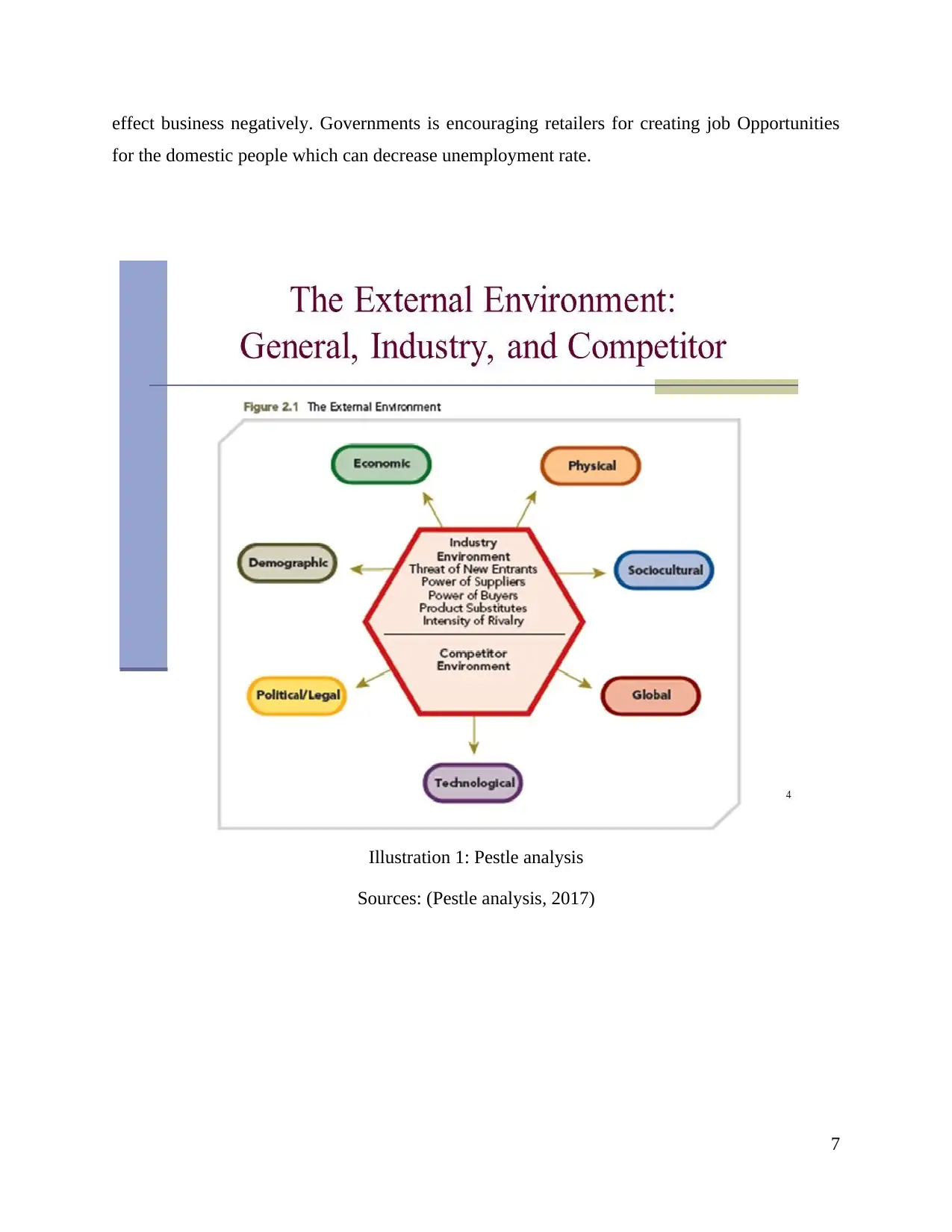
effect business negatively. Governments is encouraging retailers for creating job Opportunities
for the domestic people which can decrease unemployment rate.
7
Illustration 1: Pestle analysis
Sources: (Pestle analysis, 2017)
for the domestic people which can decrease unemployment rate.
7
Illustration 1: Pestle analysis
Sources: (Pestle analysis, 2017)
You're viewing a preview
Unlock full access by subscribing today!
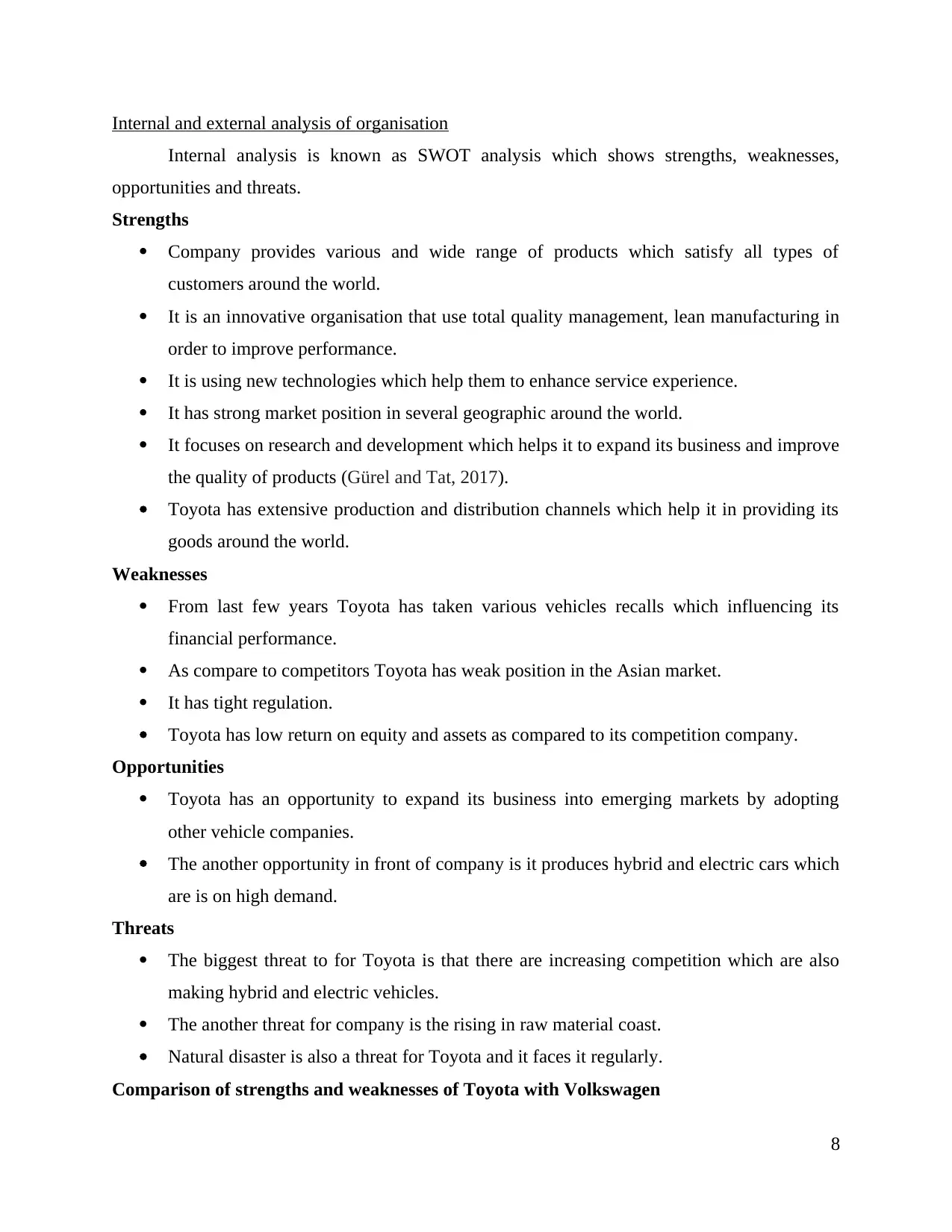
Internal and external analysis of organisation
Internal analysis is known as SWOT analysis which shows strengths, weaknesses,
opportunities and threats.
Strengths
Company provides various and wide range of products which satisfy all types of
customers around the world.
It is an innovative organisation that use total quality management, lean manufacturing in
order to improve performance.
It is using new technologies which help them to enhance service experience.
It has strong market position in several geographic around the world.
It focuses on research and development which helps it to expand its business and improve
the quality of products (Gürel and Tat, 2017).
Toyota has extensive production and distribution channels which help it in providing its
goods around the world.
Weaknesses
From last few years Toyota has taken various vehicles recalls which influencing its
financial performance.
As compare to competitors Toyota has weak position in the Asian market.
It has tight regulation.
Toyota has low return on equity and assets as compared to its competition company.
Opportunities
Toyota has an opportunity to expand its business into emerging markets by adopting
other vehicle companies.
The another opportunity in front of company is it produces hybrid and electric cars which
are is on high demand.
Threats
The biggest threat to for Toyota is that there are increasing competition which are also
making hybrid and electric vehicles.
The another threat for company is the rising in raw material coast.
Natural disaster is also a threat for Toyota and it faces it regularly.
Comparison of strengths and weaknesses of Toyota with Volkswagen
8
Internal analysis is known as SWOT analysis which shows strengths, weaknesses,
opportunities and threats.
Strengths
Company provides various and wide range of products which satisfy all types of
customers around the world.
It is an innovative organisation that use total quality management, lean manufacturing in
order to improve performance.
It is using new technologies which help them to enhance service experience.
It has strong market position in several geographic around the world.
It focuses on research and development which helps it to expand its business and improve
the quality of products (Gürel and Tat, 2017).
Toyota has extensive production and distribution channels which help it in providing its
goods around the world.
Weaknesses
From last few years Toyota has taken various vehicles recalls which influencing its
financial performance.
As compare to competitors Toyota has weak position in the Asian market.
It has tight regulation.
Toyota has low return on equity and assets as compared to its competition company.
Opportunities
Toyota has an opportunity to expand its business into emerging markets by adopting
other vehicle companies.
The another opportunity in front of company is it produces hybrid and electric cars which
are is on high demand.
Threats
The biggest threat to for Toyota is that there are increasing competition which are also
making hybrid and electric vehicles.
The another threat for company is the rising in raw material coast.
Natural disaster is also a threat for Toyota and it faces it regularly.
Comparison of strengths and weaknesses of Toyota with Volkswagen
8
Paraphrase This Document
Need a fresh take? Get an instant paraphrase of this document with our AI Paraphraser
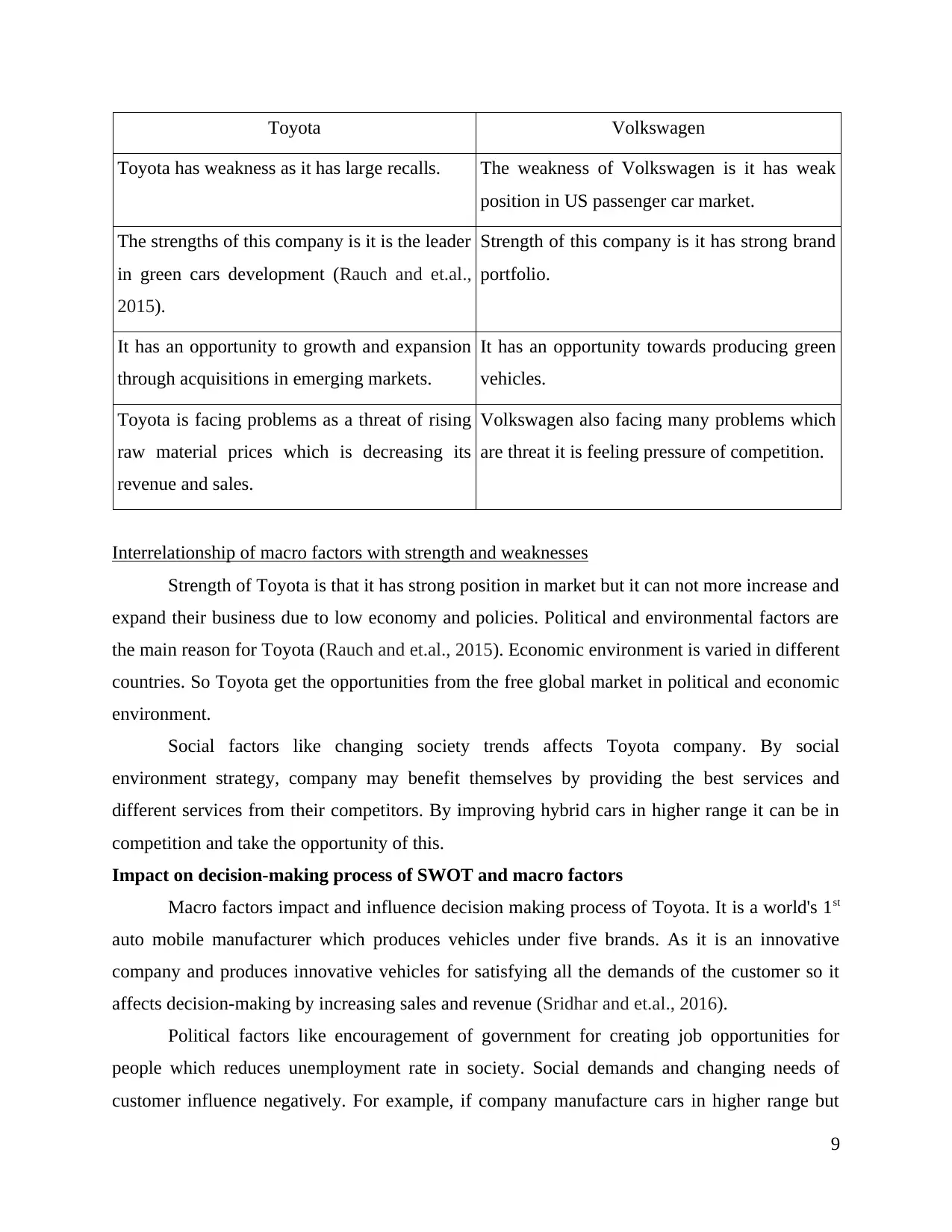
Toyota Volkswagen
Toyota has weakness as it has large recalls. The weakness of Volkswagen is it has weak
position in US passenger car market.
The strengths of this company is it is the leader
in green cars development (Rauch and et.al.,
2015).
Strength of this company is it has strong brand
portfolio.
It has an opportunity to growth and expansion
through acquisitions in emerging markets.
It has an opportunity towards producing green
vehicles.
Toyota is facing problems as a threat of rising
raw material prices which is decreasing its
revenue and sales.
Volkswagen also facing many problems which
are threat it is feeling pressure of competition.
Interrelationship of macro factors with strength and weaknesses
Strength of Toyota is that it has strong position in market but it can not more increase and
expand their business due to low economy and policies. Political and environmental factors are
the main reason for Toyota (Rauch and et.al., 2015). Economic environment is varied in different
countries. So Toyota get the opportunities from the free global market in political and economic
environment.
Social factors like changing society trends affects Toyota company. By social
environment strategy, company may benefit themselves by providing the best services and
different services from their competitors. By improving hybrid cars in higher range it can be in
competition and take the opportunity of this.
Impact on decision-making process of SWOT and macro factors
Macro factors impact and influence decision making process of Toyota. It is a world's 1st
auto mobile manufacturer which produces vehicles under five brands. As it is an innovative
company and produces innovative vehicles for satisfying all the demands of the customer so it
affects decision-making by increasing sales and revenue (Sridhar and et.al., 2016).
Political factors like encouragement of government for creating job opportunities for
people which reduces unemployment rate in society. Social demands and changing needs of
customer influence negatively. For example, if company manufacture cars in higher range but
9
Toyota has weakness as it has large recalls. The weakness of Volkswagen is it has weak
position in US passenger car market.
The strengths of this company is it is the leader
in green cars development (Rauch and et.al.,
2015).
Strength of this company is it has strong brand
portfolio.
It has an opportunity to growth and expansion
through acquisitions in emerging markets.
It has an opportunity towards producing green
vehicles.
Toyota is facing problems as a threat of rising
raw material prices which is decreasing its
revenue and sales.
Volkswagen also facing many problems which
are threat it is feeling pressure of competition.
Interrelationship of macro factors with strength and weaknesses
Strength of Toyota is that it has strong position in market but it can not more increase and
expand their business due to low economy and policies. Political and environmental factors are
the main reason for Toyota (Rauch and et.al., 2015). Economic environment is varied in different
countries. So Toyota get the opportunities from the free global market in political and economic
environment.
Social factors like changing society trends affects Toyota company. By social
environment strategy, company may benefit themselves by providing the best services and
different services from their competitors. By improving hybrid cars in higher range it can be in
competition and take the opportunity of this.
Impact on decision-making process of SWOT and macro factors
Macro factors impact and influence decision making process of Toyota. It is a world's 1st
auto mobile manufacturer which produces vehicles under five brands. As it is an innovative
company and produces innovative vehicles for satisfying all the demands of the customer so it
affects decision-making by increasing sales and revenue (Sridhar and et.al., 2016).
Political factors like encouragement of government for creating job opportunities for
people which reduces unemployment rate in society. Social demands and changing needs of
customer influence negatively. For example, if company manufacture cars in higher range but
9
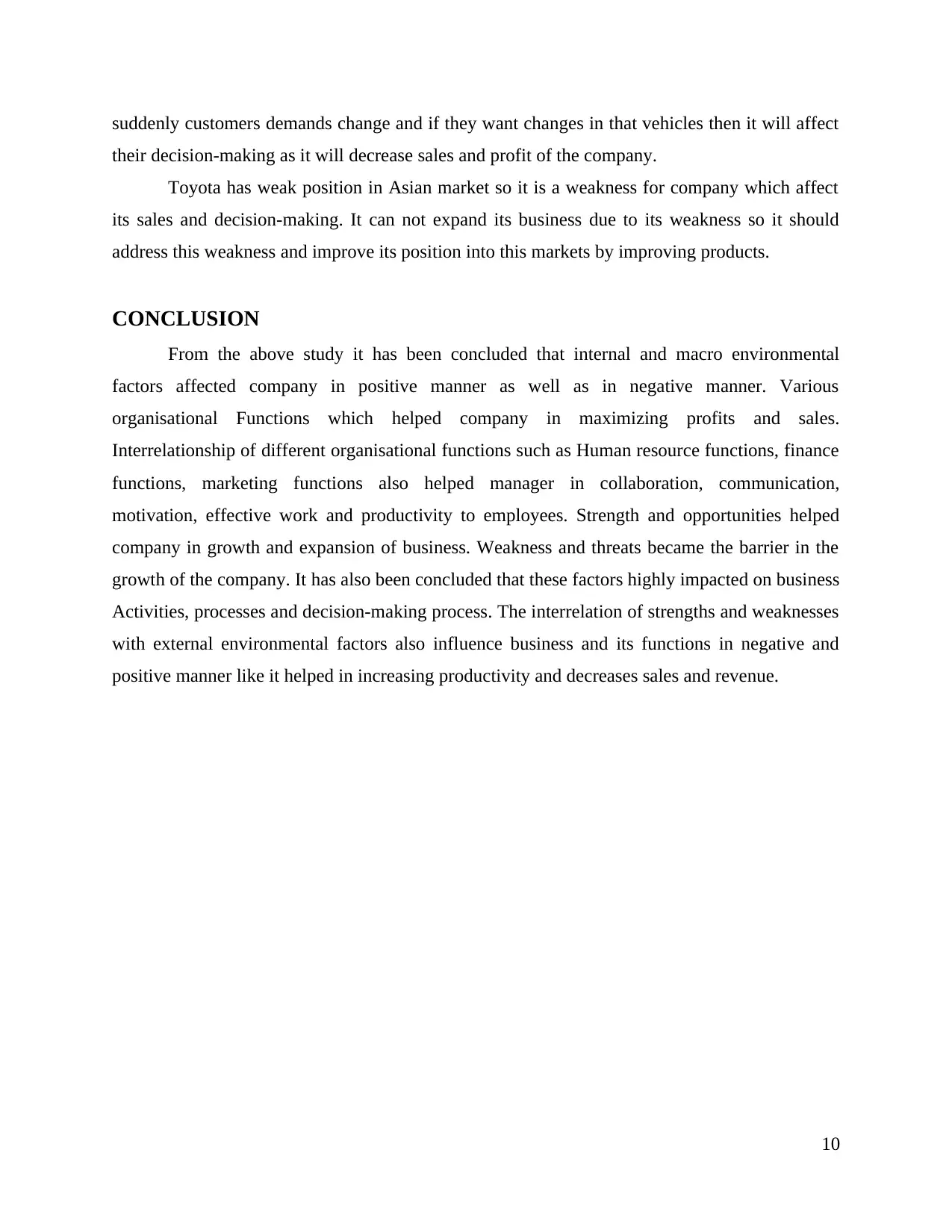
suddenly customers demands change and if they want changes in that vehicles then it will affect
their decision-making as it will decrease sales and profit of the company.
Toyota has weak position in Asian market so it is a weakness for company which affect
its sales and decision-making. It can not expand its business due to its weakness so it should
address this weakness and improve its position into this markets by improving products.
CONCLUSION
From the above study it has been concluded that internal and macro environmental
factors affected company in positive manner as well as in negative manner. Various
organisational Functions which helped company in maximizing profits and sales.
Interrelationship of different organisational functions such as Human resource functions, finance
functions, marketing functions also helped manager in collaboration, communication,
motivation, effective work and productivity to employees. Strength and opportunities helped
company in growth and expansion of business. Weakness and threats became the barrier in the
growth of the company. It has also been concluded that these factors highly impacted on business
Activities, processes and decision-making process. The interrelation of strengths and weaknesses
with external environmental factors also influence business and its functions in negative and
positive manner like it helped in increasing productivity and decreases sales and revenue.
10
their decision-making as it will decrease sales and profit of the company.
Toyota has weak position in Asian market so it is a weakness for company which affect
its sales and decision-making. It can not expand its business due to its weakness so it should
address this weakness and improve its position into this markets by improving products.
CONCLUSION
From the above study it has been concluded that internal and macro environmental
factors affected company in positive manner as well as in negative manner. Various
organisational Functions which helped company in maximizing profits and sales.
Interrelationship of different organisational functions such as Human resource functions, finance
functions, marketing functions also helped manager in collaboration, communication,
motivation, effective work and productivity to employees. Strength and opportunities helped
company in growth and expansion of business. Weakness and threats became the barrier in the
growth of the company. It has also been concluded that these factors highly impacted on business
Activities, processes and decision-making process. The interrelation of strengths and weaknesses
with external environmental factors also influence business and its functions in negative and
positive manner like it helped in increasing productivity and decreases sales and revenue.
10
You're viewing a preview
Unlock full access by subscribing today!

REFERENCES
Books and journals
Bah, E.H. and Fang, L., 2015. Impact of the business environment on output and productivity in
Africa. Journal of Development Economics, 114, pp.159-171.
Bull, J.W. and et.al., 2016. Strengths, Weaknesses, Opportunities and Threats: A SWOT analysis
of the ecosystem services framework. Ecosystem services, 17, pp.99-111.
BV, T.M.F.N., 2017. The company.
Chang, J.F., 2016. Business process management systems: strategy and implementation.
Auerbach Publications.
Fairfield, K.D., 2016. Understanding functional and divisional organizational structure: A
classroom exercise. Management Teaching Review, 1(4), pp.242-251.
Gürel, E. and Tat, M., 2017. SWOT ANALYSIS: A THEORETICAL REVIEW. Journal of
International Social Research, 10(51).
Hsu, L. and Lawrence, B., 2016. The role of social media and brand equity during a product
recall crisis: A shareholder value perspective. International journal of research in
Marketing, 33(1), pp.59-77.
O’Brien, D. and Gowthrop, L., 2016. Organizational structure. The Sage handbook of sport
management, pp.39-61.
Rauch, P. and et.al., 2015. SWOT analysis and strategy development for forest fuel supply
chains in South East Europe. Forest Policy and Economics, 61, pp.87-94.
Richardson, R., Shin, H. and Soluade, O., 2018. A vehicle recall index and the sales impact by
type of recall. International Journal of Business Continuity and Risk Management, 8(3),
pp.232-248.
Sridhar, R. and et.al., 2016. A Political, Economic, Social, Technological, Legal and
Environmental (PESTLE) approach for assessment of coastal zone management
practice in India. International Review of Public Administration, 21(3), pp.216-232.
Westerburg, M. and Bode, C., 2018, July. Sources of Supply Chain Risk: External
Environmental Factors or Strategic Choice?. In Academy of Management
Proceedings (Vol. 2018, No. 1, p. 14532). Briarcliff Manor, NY 10510: Academy of
Management.
11
Books and journals
Bah, E.H. and Fang, L., 2015. Impact of the business environment on output and productivity in
Africa. Journal of Development Economics, 114, pp.159-171.
Bull, J.W. and et.al., 2016. Strengths, Weaknesses, Opportunities and Threats: A SWOT analysis
of the ecosystem services framework. Ecosystem services, 17, pp.99-111.
BV, T.M.F.N., 2017. The company.
Chang, J.F., 2016. Business process management systems: strategy and implementation.
Auerbach Publications.
Fairfield, K.D., 2016. Understanding functional and divisional organizational structure: A
classroom exercise. Management Teaching Review, 1(4), pp.242-251.
Gürel, E. and Tat, M., 2017. SWOT ANALYSIS: A THEORETICAL REVIEW. Journal of
International Social Research, 10(51).
Hsu, L. and Lawrence, B., 2016. The role of social media and brand equity during a product
recall crisis: A shareholder value perspective. International journal of research in
Marketing, 33(1), pp.59-77.
O’Brien, D. and Gowthrop, L., 2016. Organizational structure. The Sage handbook of sport
management, pp.39-61.
Rauch, P. and et.al., 2015. SWOT analysis and strategy development for forest fuel supply
chains in South East Europe. Forest Policy and Economics, 61, pp.87-94.
Richardson, R., Shin, H. and Soluade, O., 2018. A vehicle recall index and the sales impact by
type of recall. International Journal of Business Continuity and Risk Management, 8(3),
pp.232-248.
Sridhar, R. and et.al., 2016. A Political, Economic, Social, Technological, Legal and
Environmental (PESTLE) approach for assessment of coastal zone management
practice in India. International Review of Public Administration, 21(3), pp.216-232.
Westerburg, M. and Bode, C., 2018, July. Sources of Supply Chain Risk: External
Environmental Factors or Strategic Choice?. In Academy of Management
Proceedings (Vol. 2018, No. 1, p. 14532). Briarcliff Manor, NY 10510: Academy of
Management.
11
Paraphrase This Document
Need a fresh take? Get an instant paraphrase of this document with our AI Paraphraser
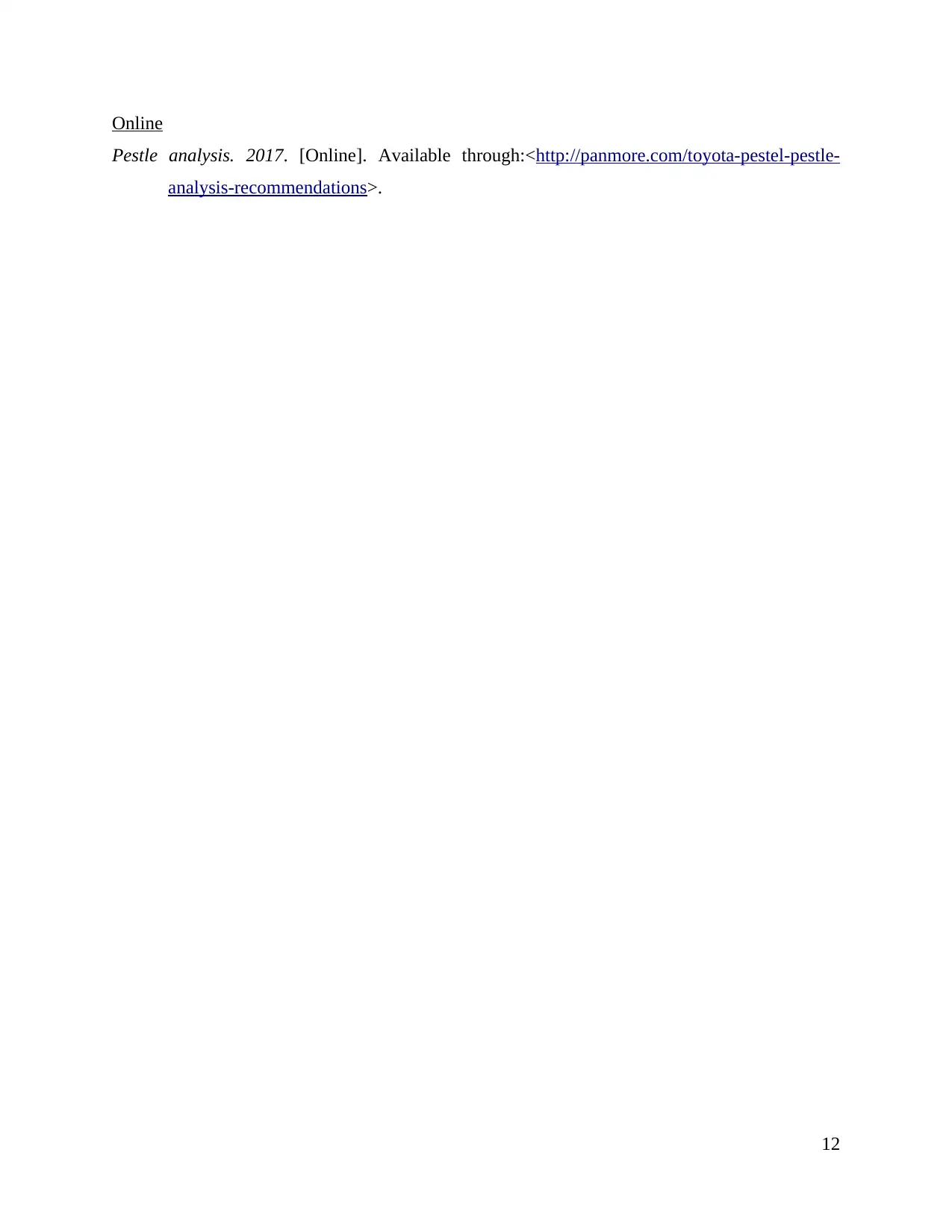
Online
Pestle analysis. 2017. [Online]. Available through:<http://panmore.com/toyota-pestel-pestle-
analysis-recommendations>.
12
Pestle analysis. 2017. [Online]. Available through:<http://panmore.com/toyota-pestel-pestle-
analysis-recommendations>.
12
1 out of 14
Related Documents
Your All-in-One AI-Powered Toolkit for Academic Success.
+13062052269
info@desklib.com
Available 24*7 on WhatsApp / Email
![[object Object]](/_next/static/media/star-bottom.7253800d.svg)
Unlock your academic potential
© 2024 | Zucol Services PVT LTD | All rights reserved.





